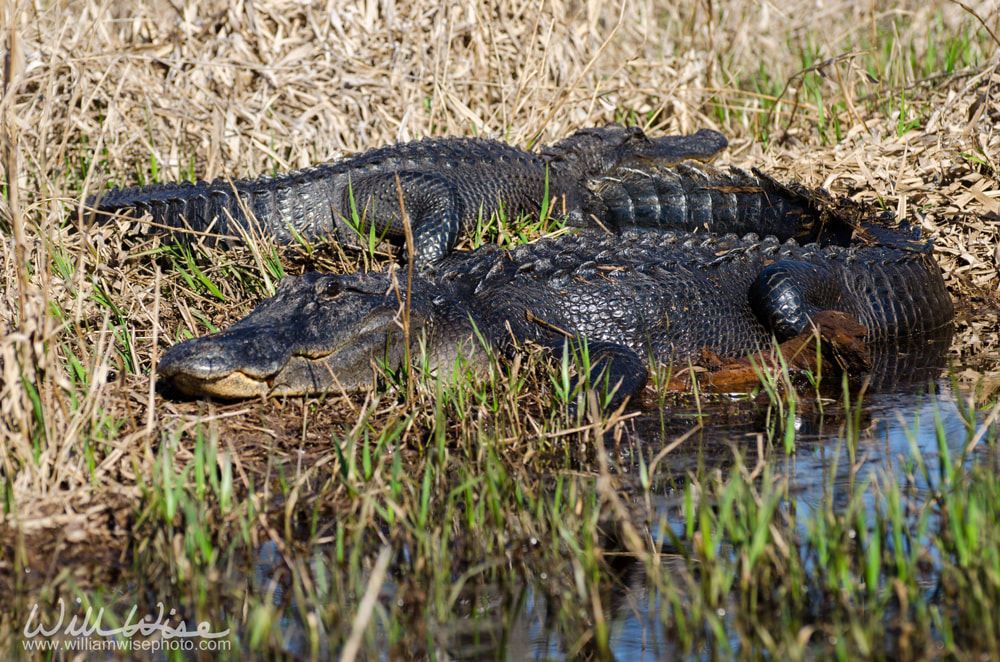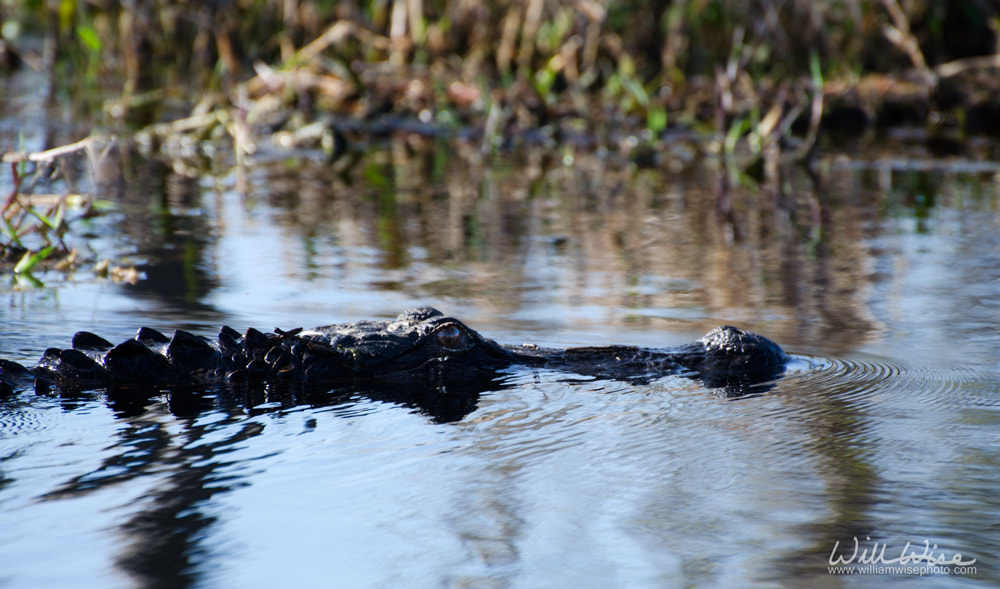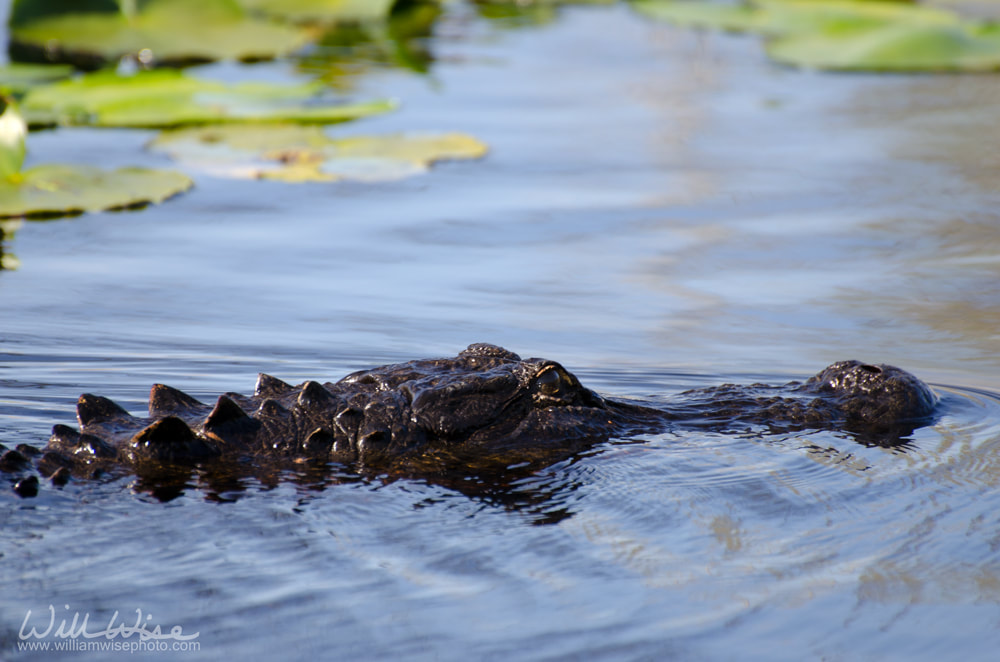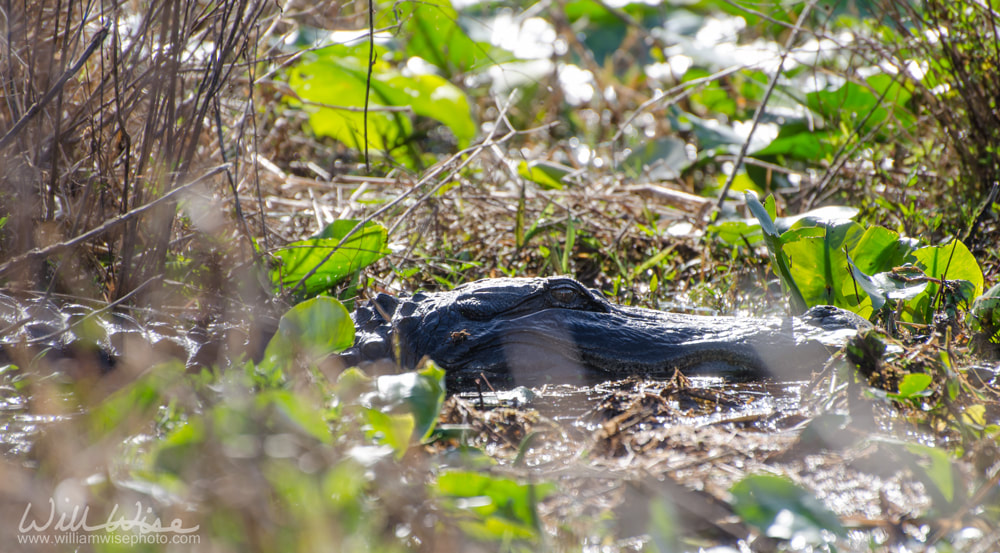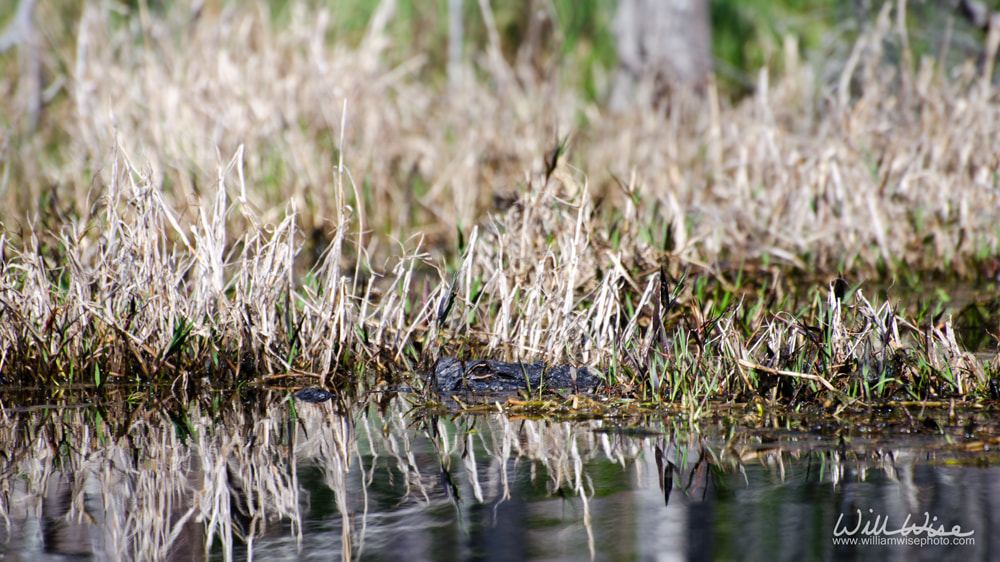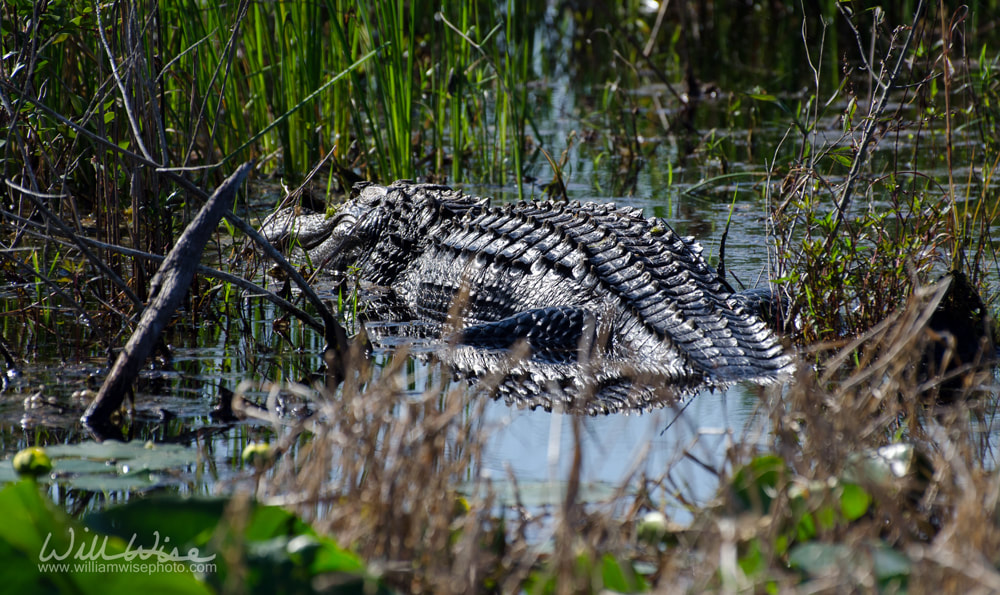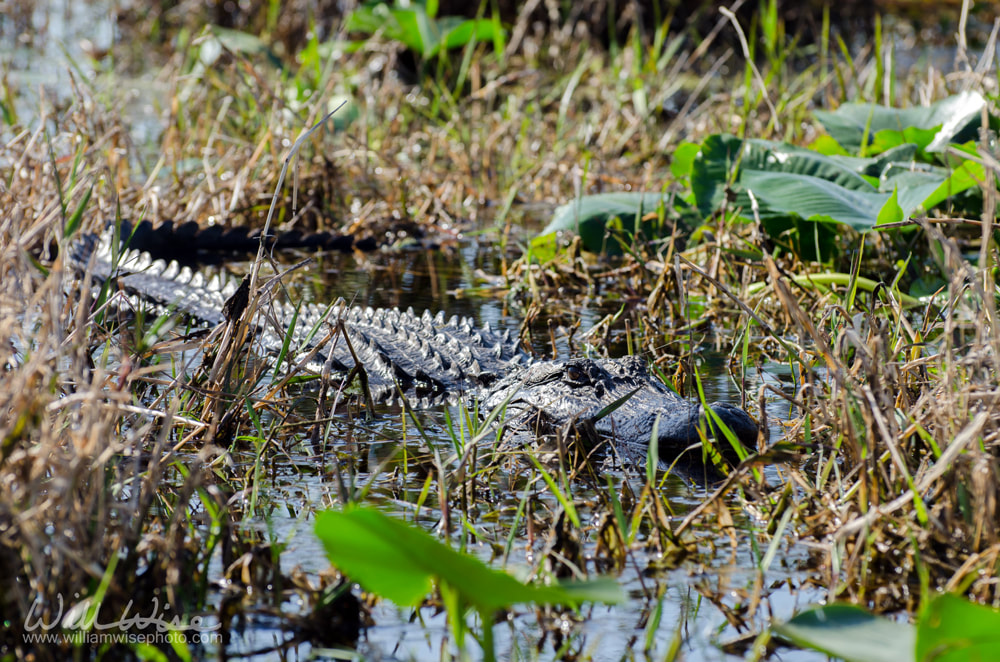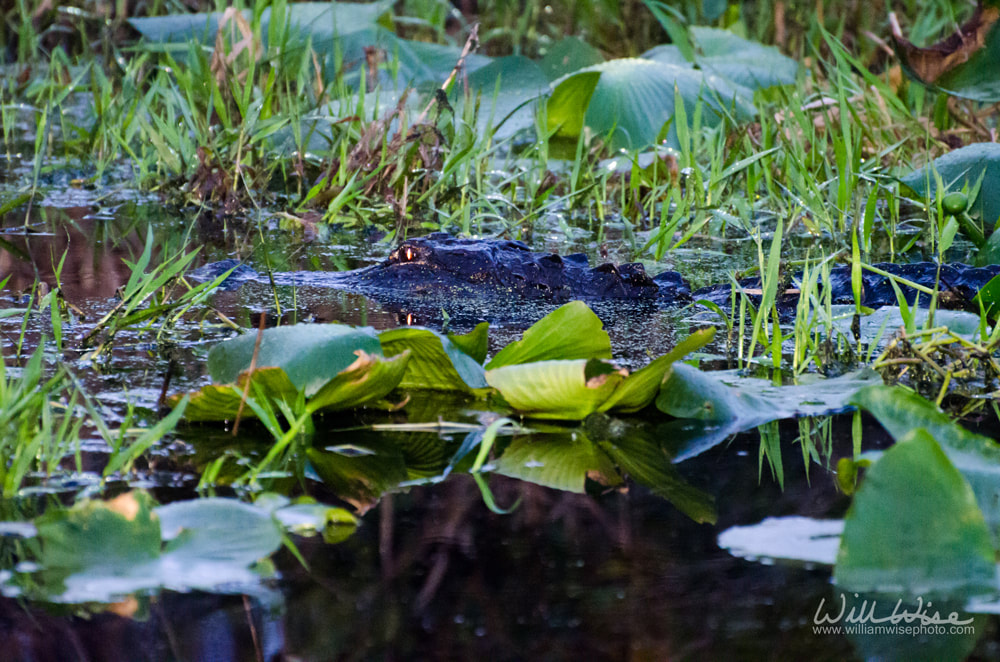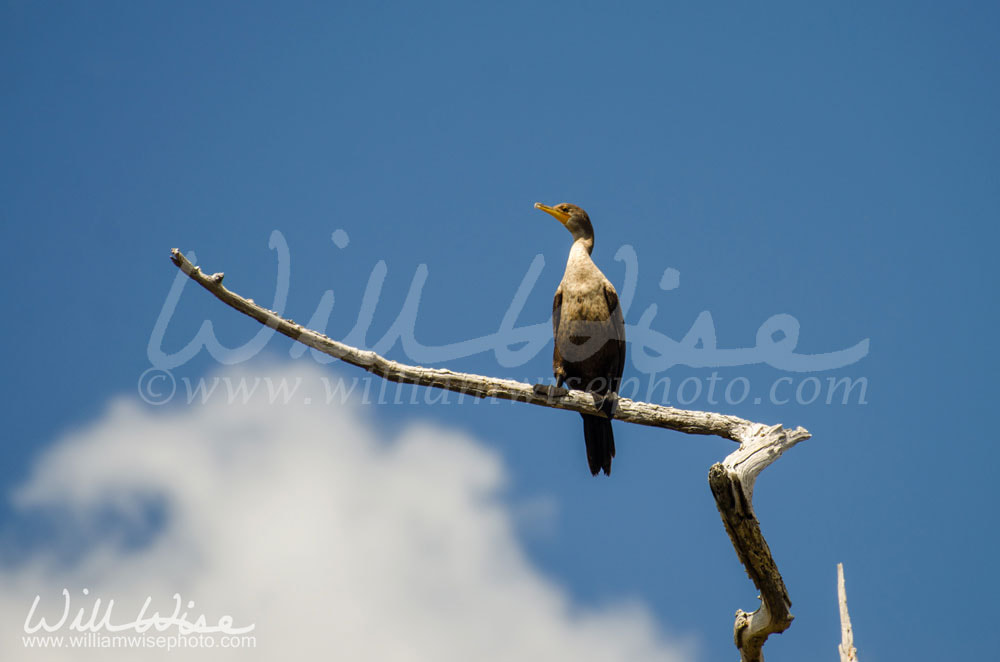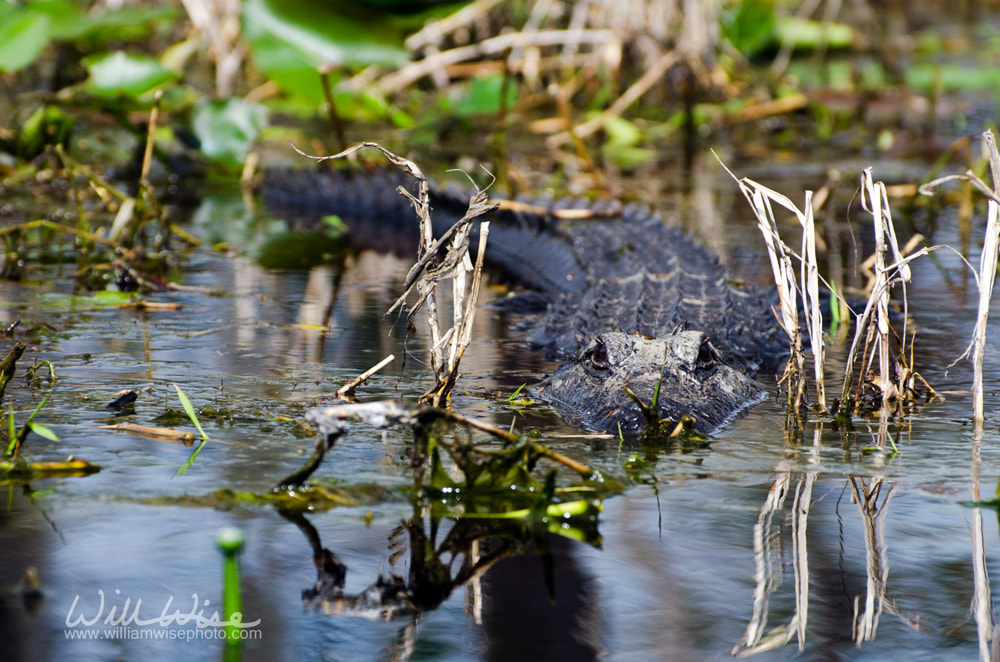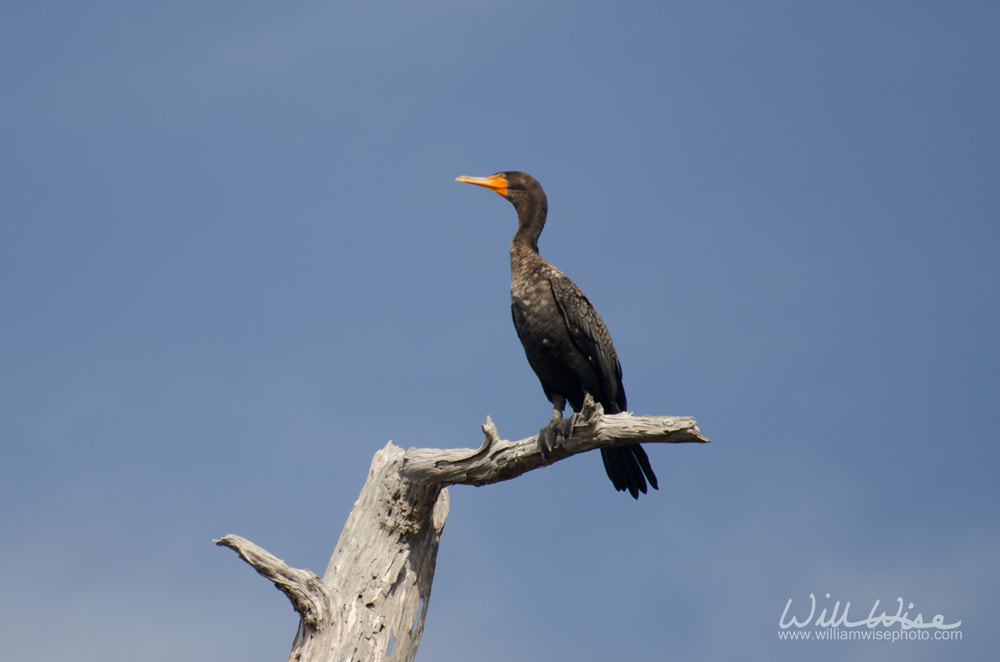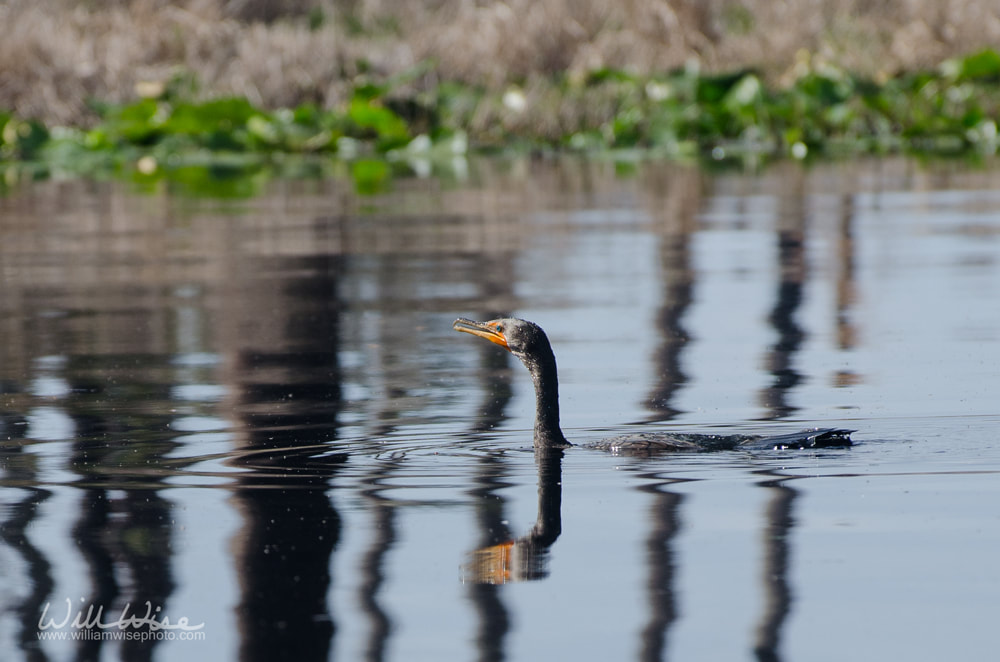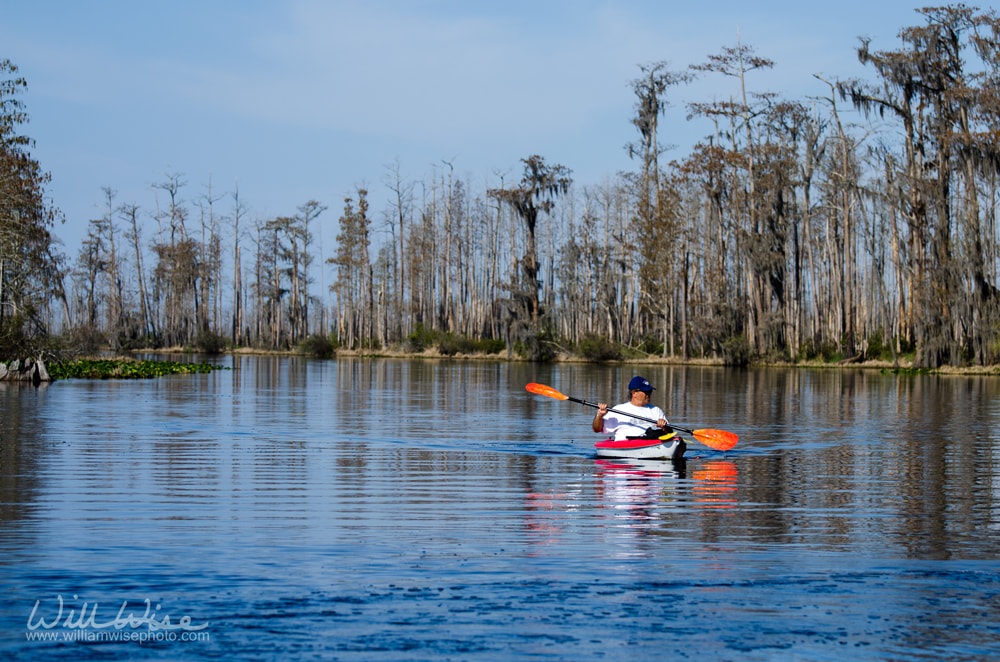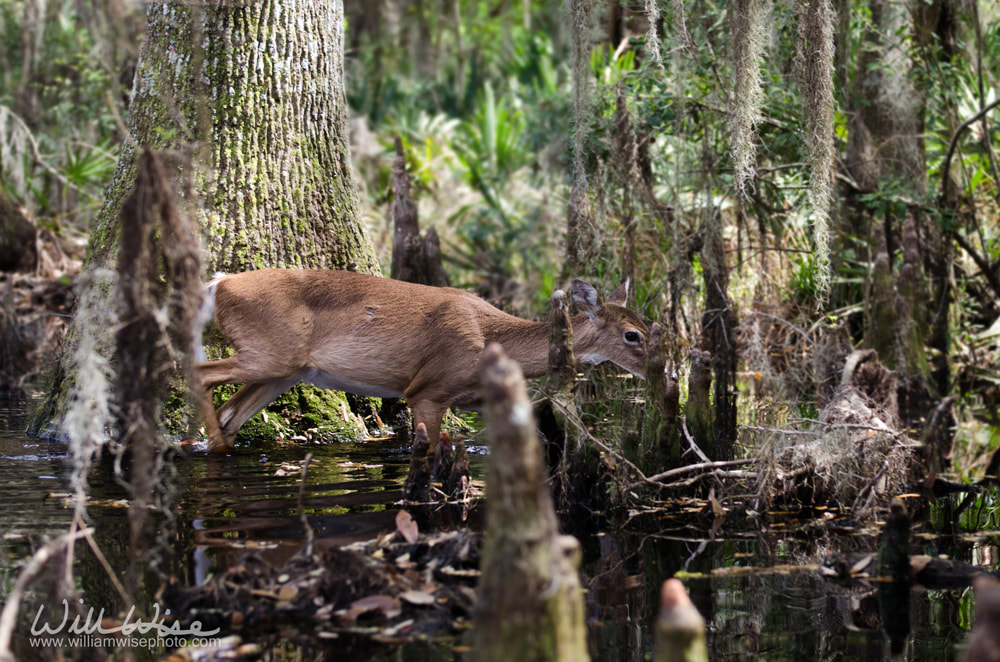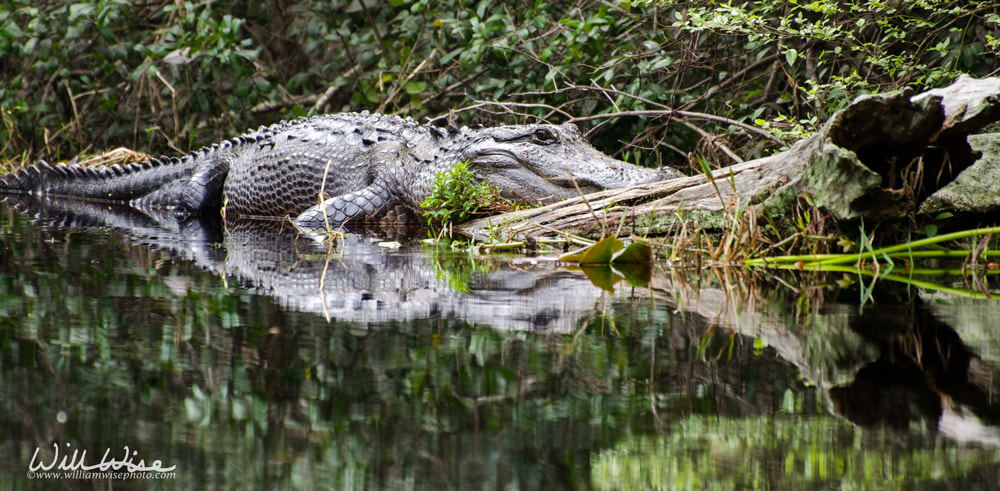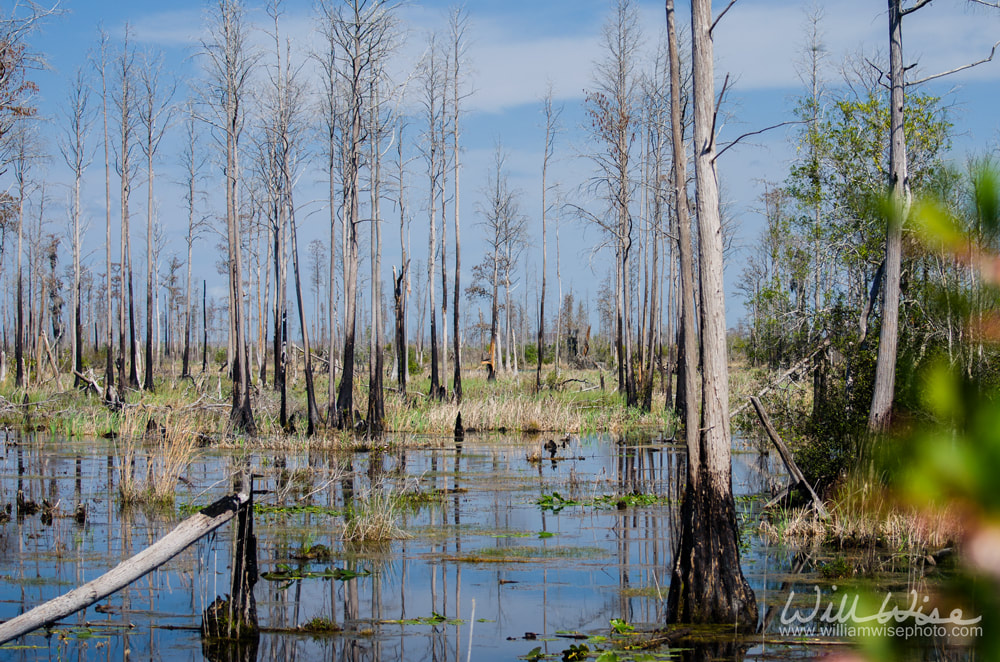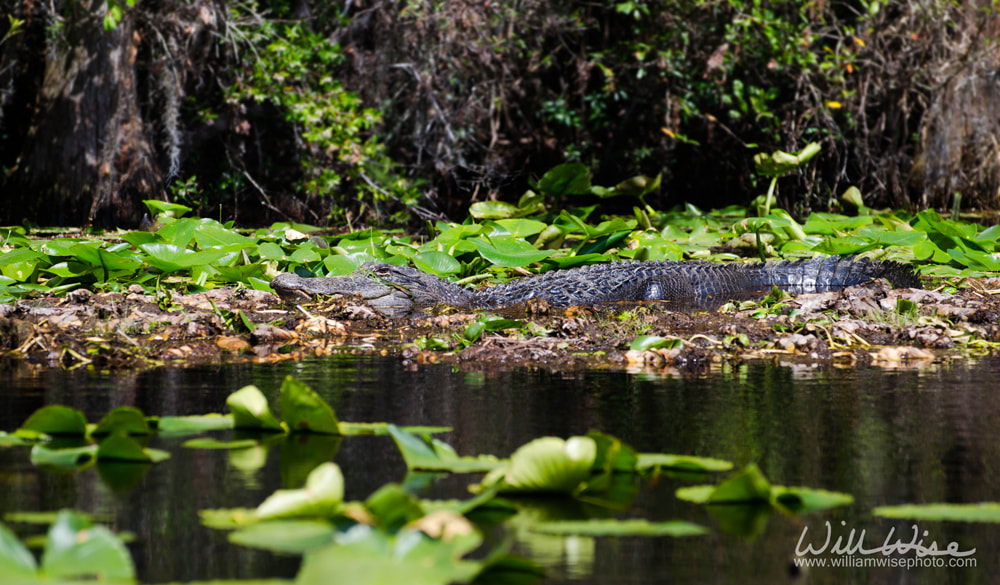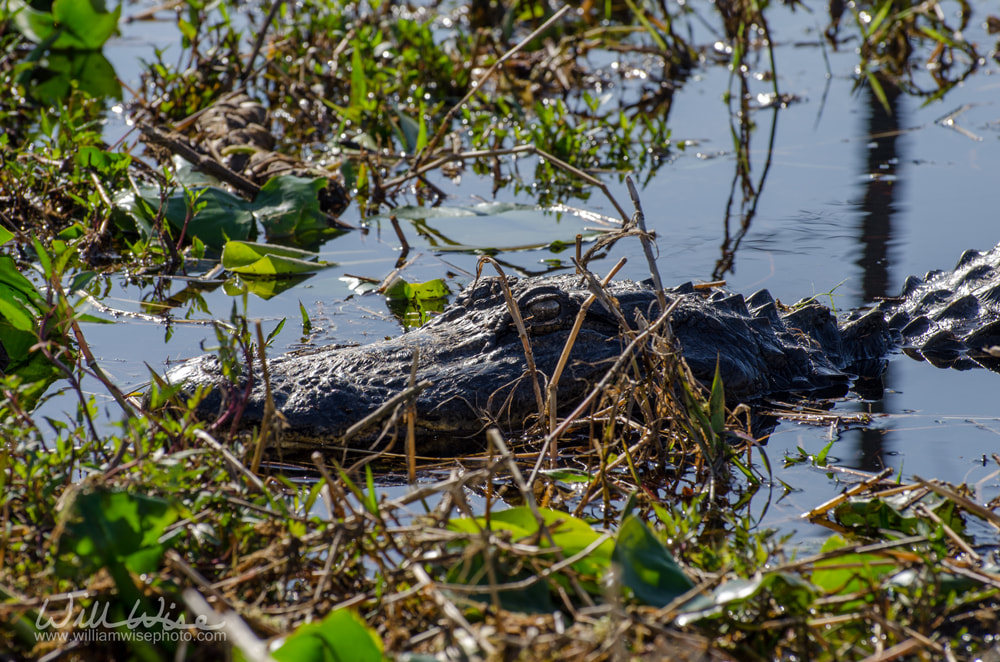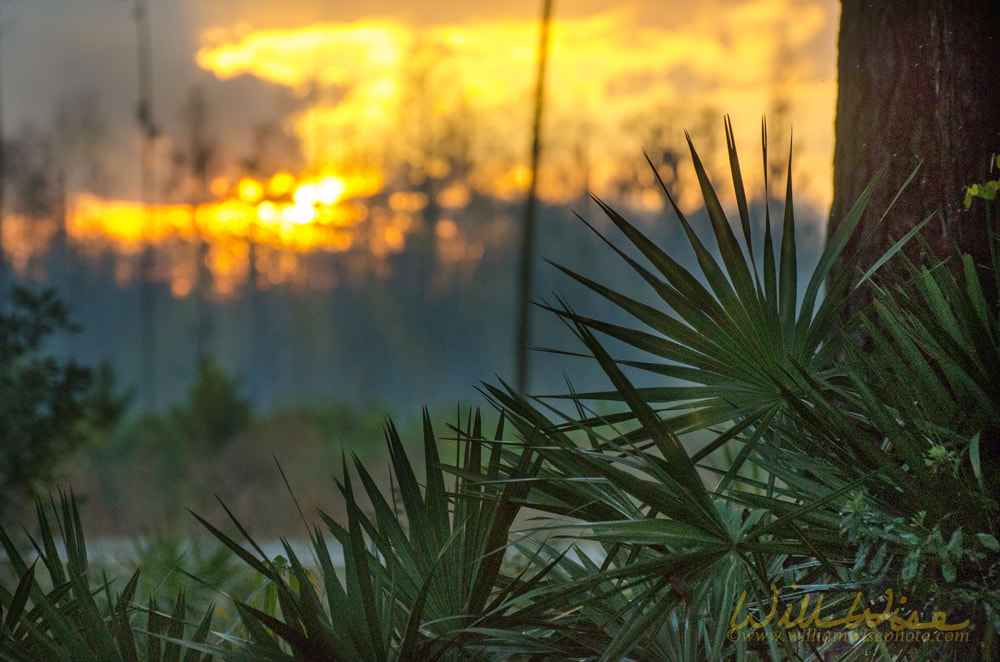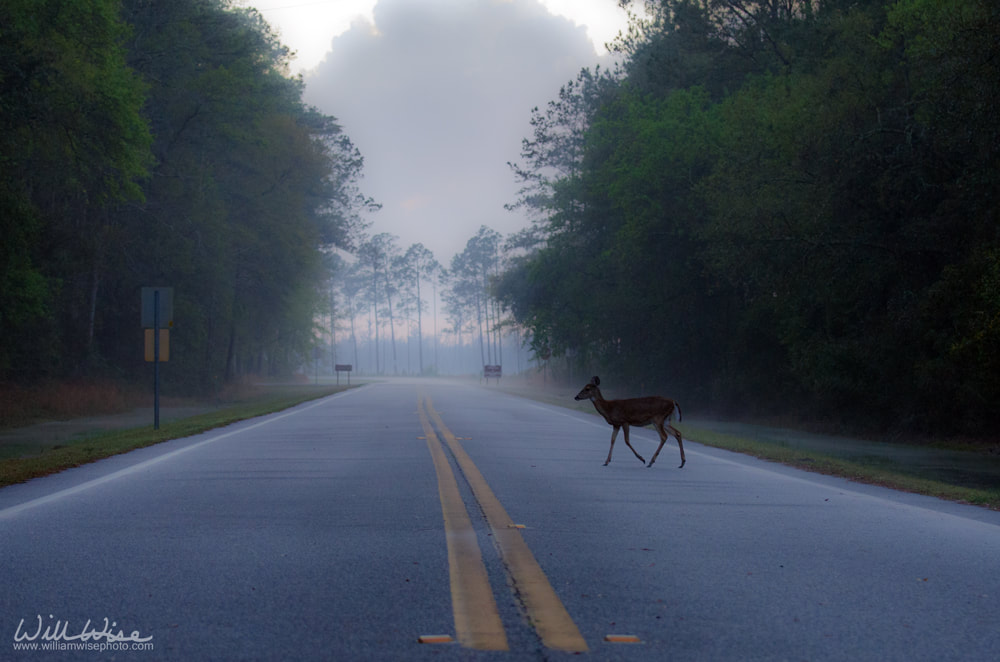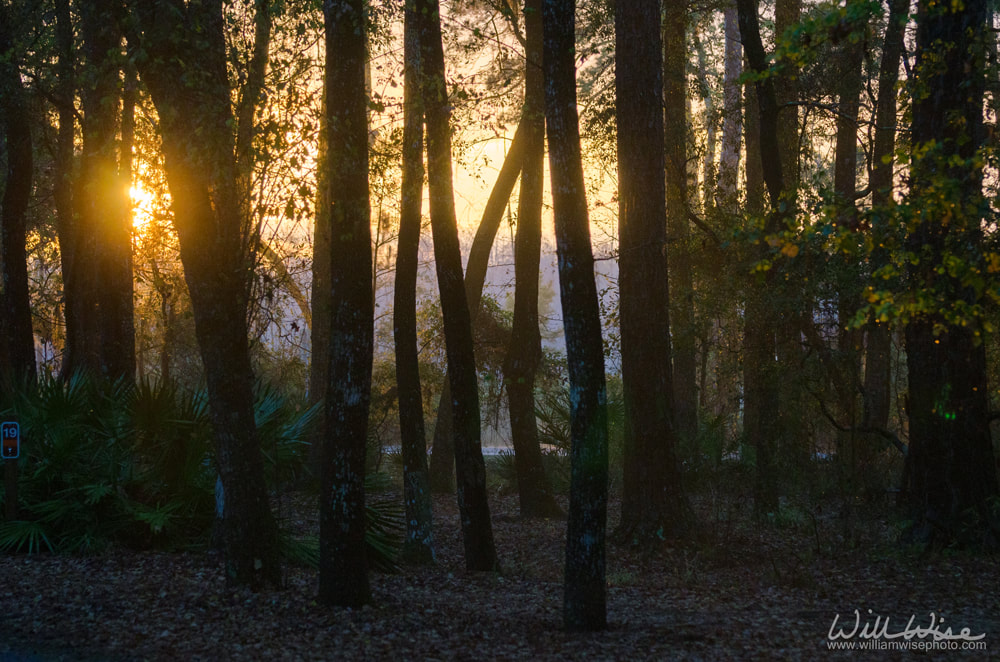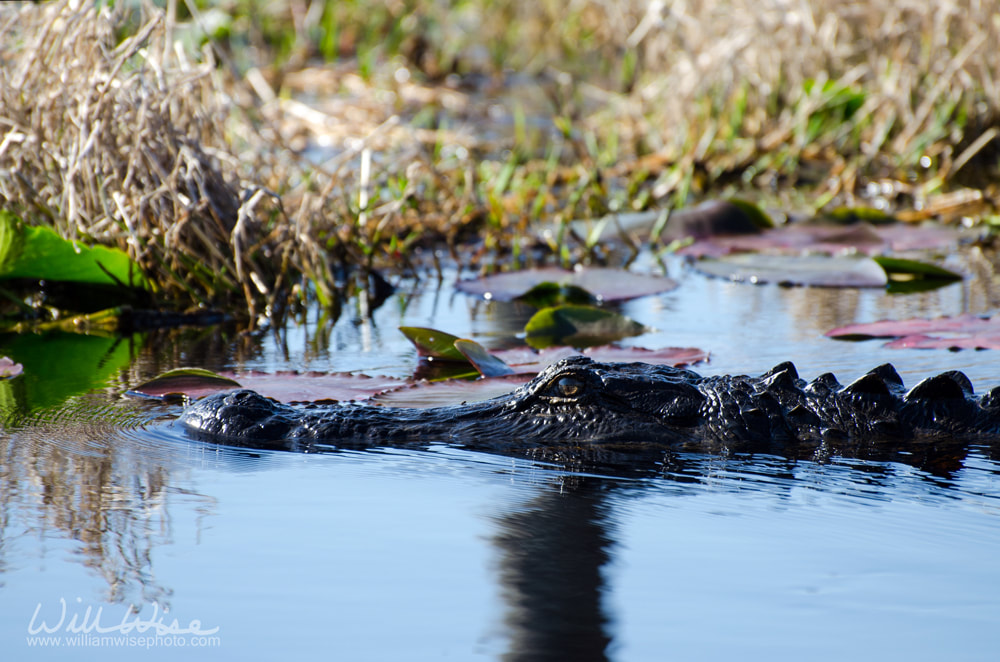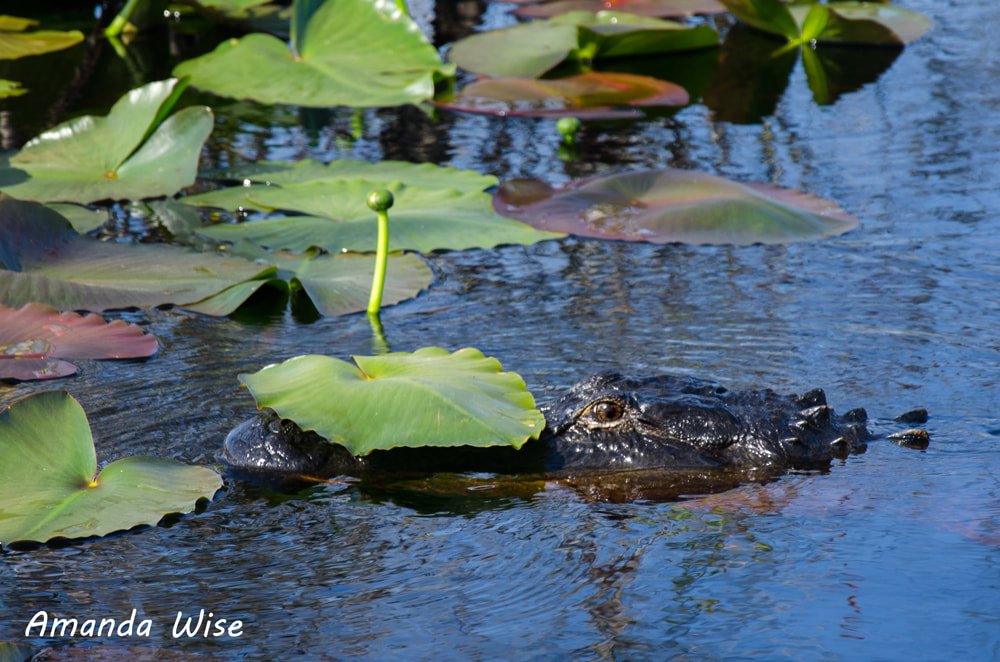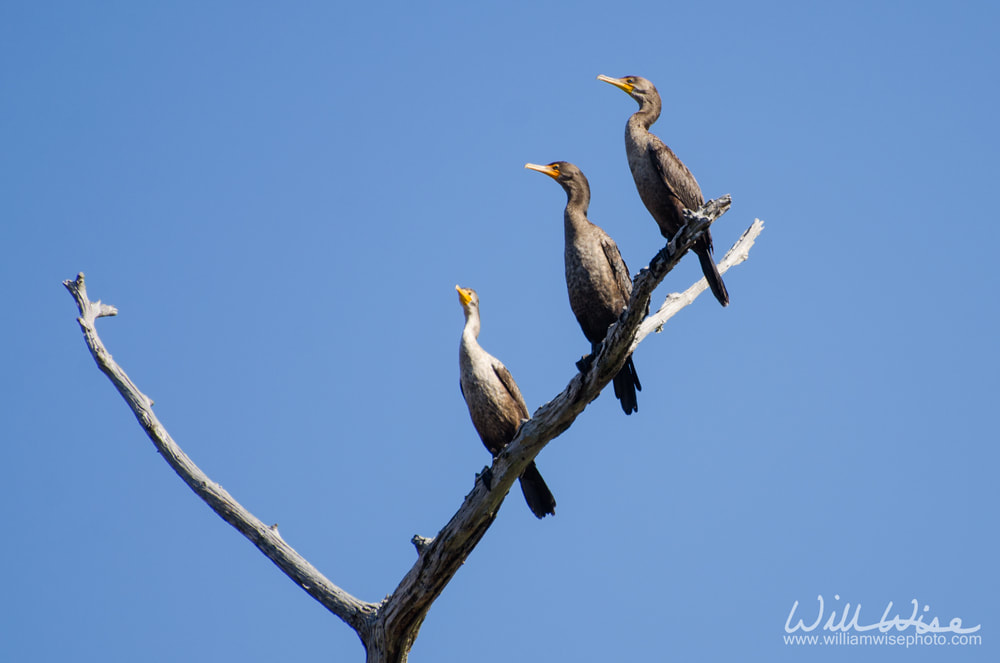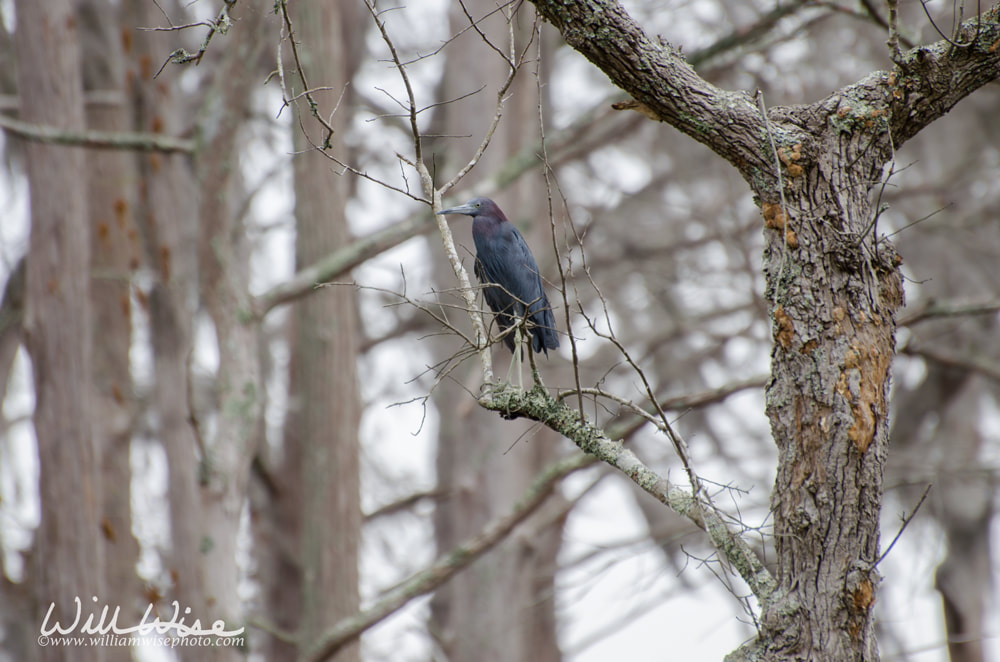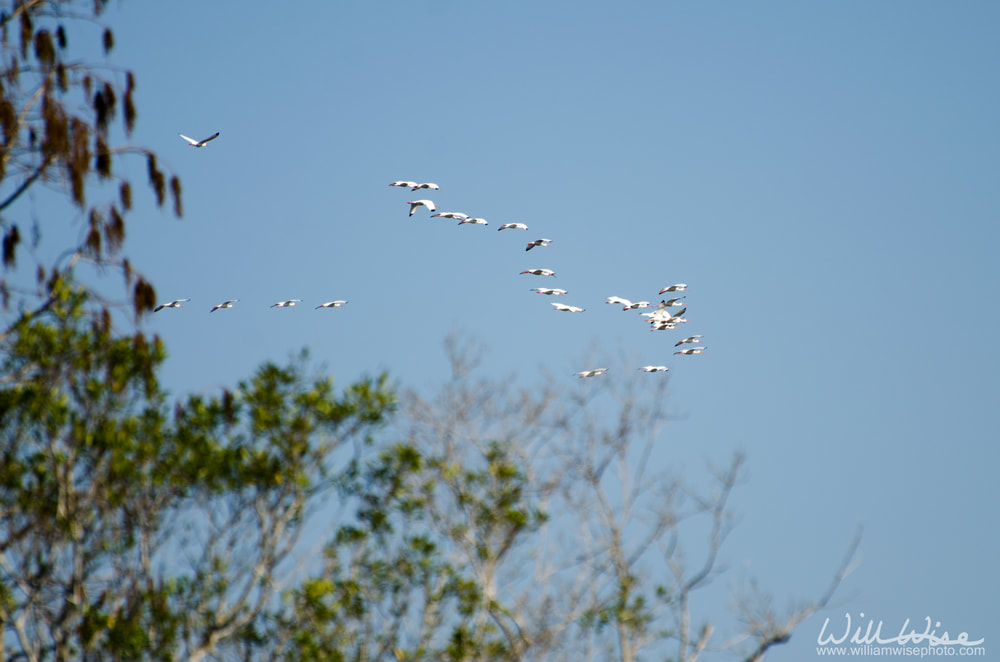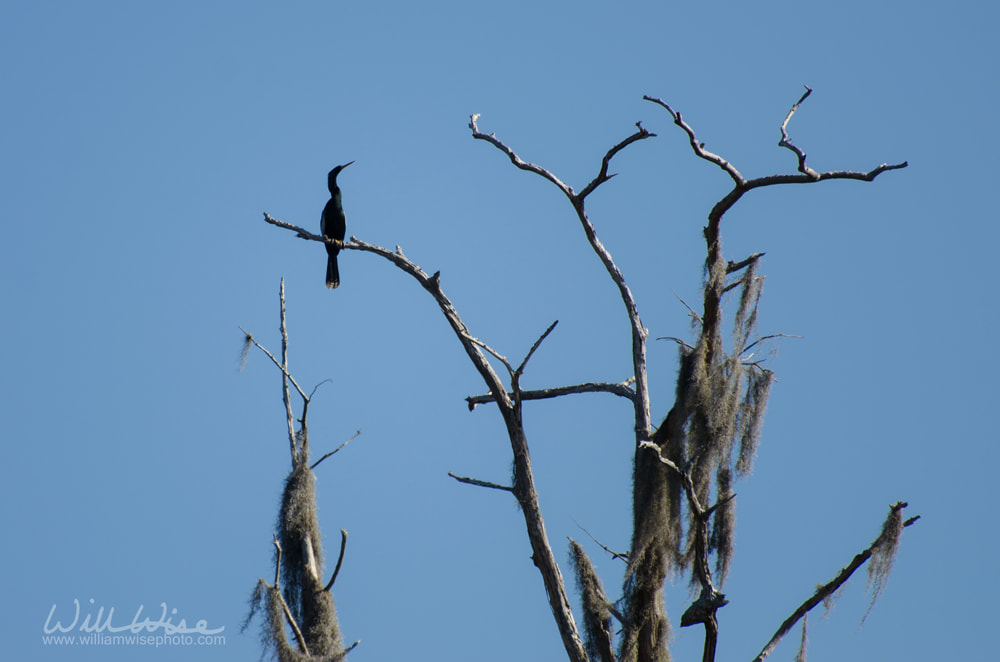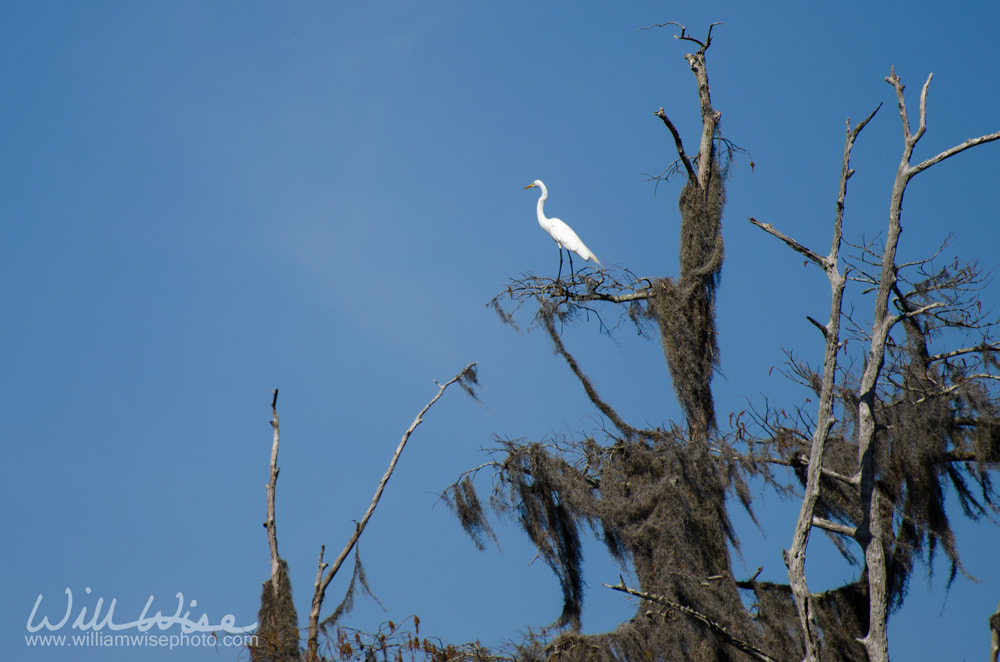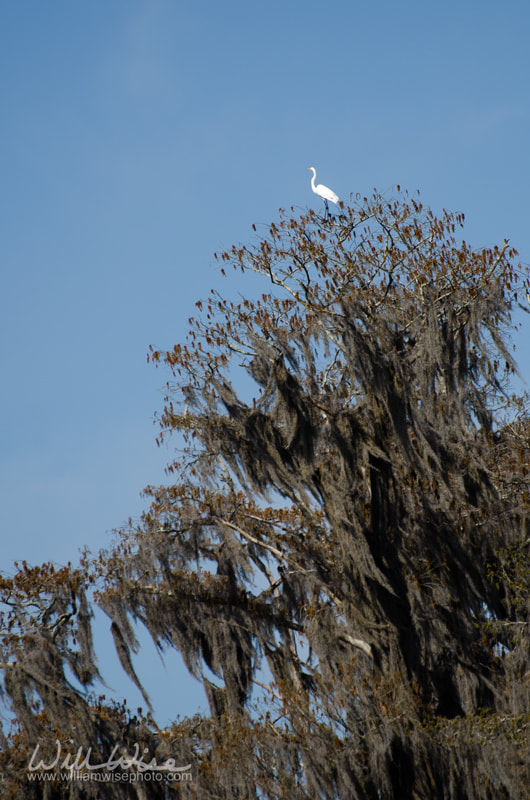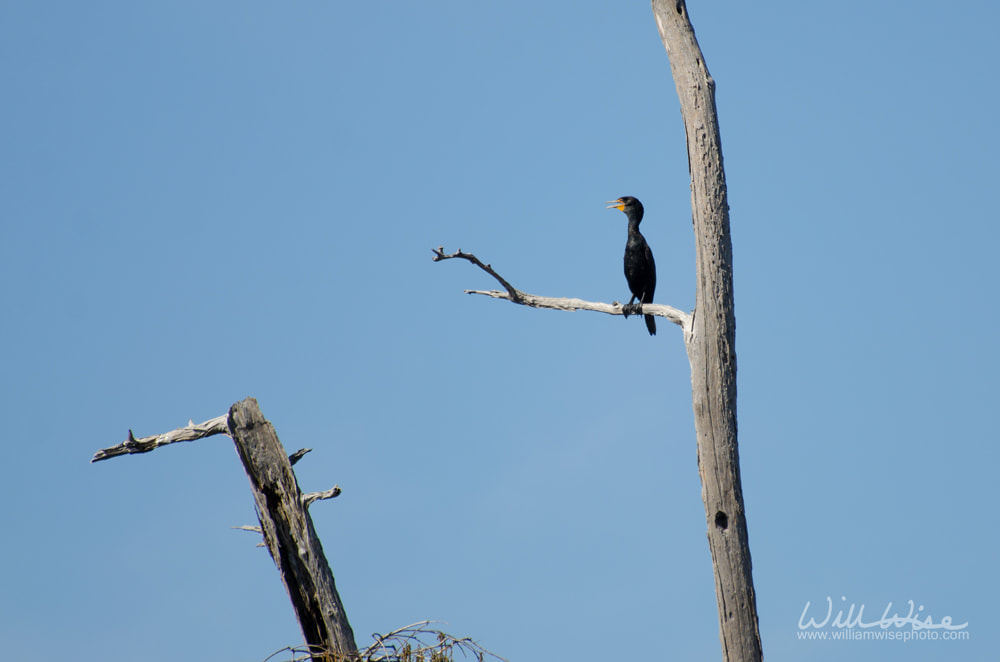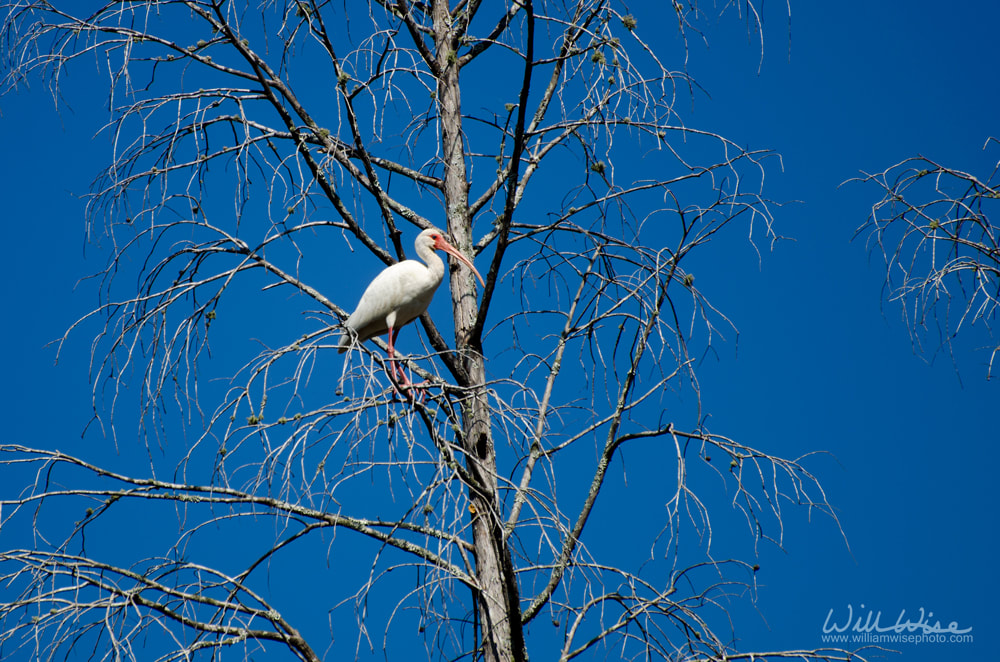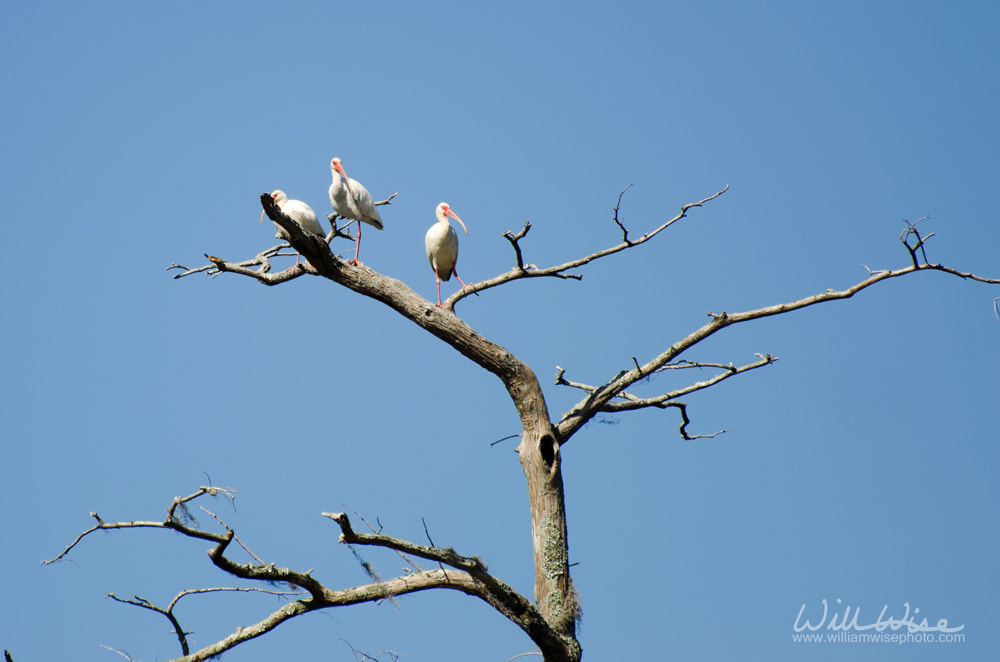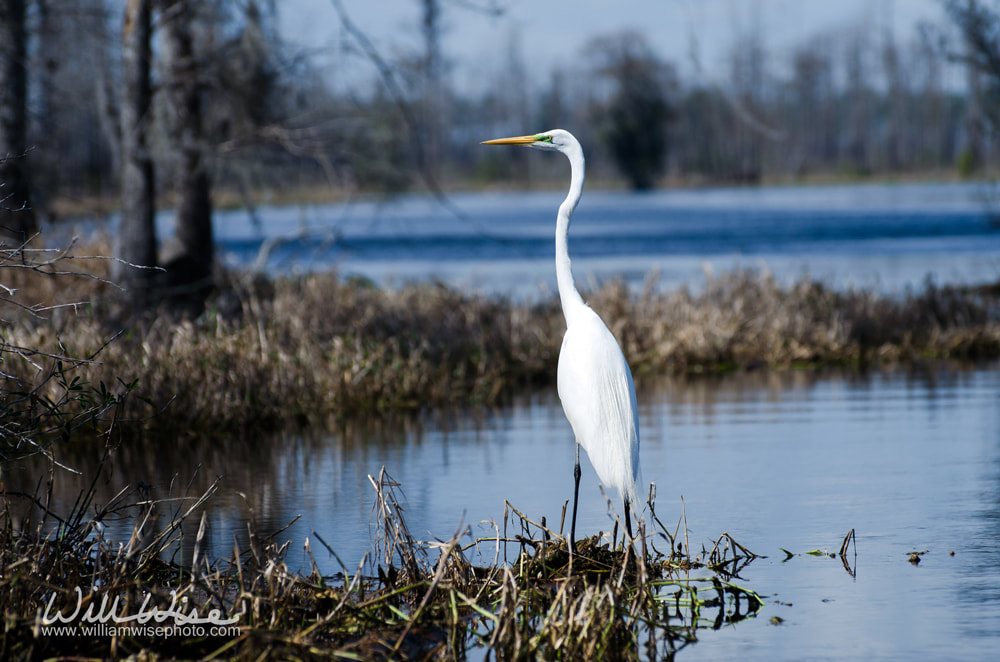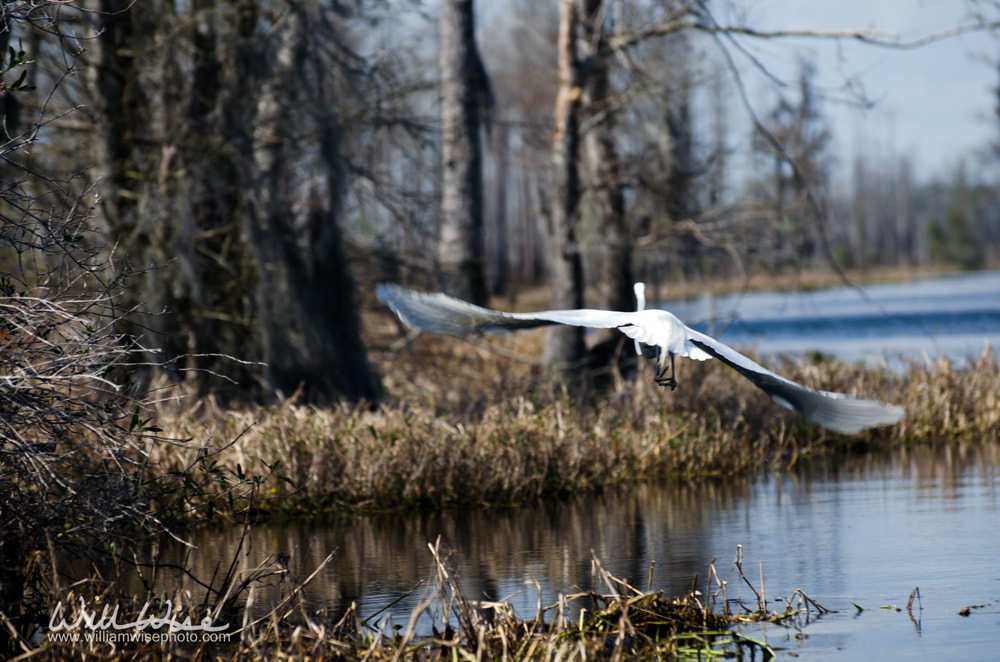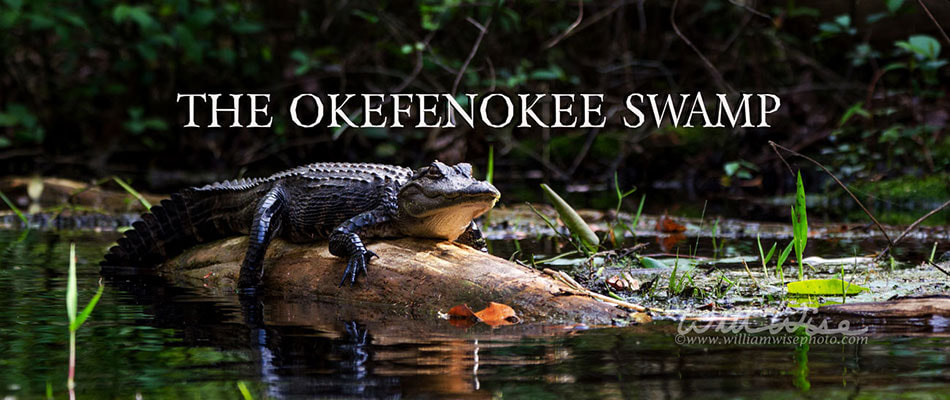 Okefenokee Photography by William Wise. A nature photo journal exploration of Georgia's Okefenokee Swamp, the Land of Trembling Earth, one of the largest blackwater swamps in North America. The alligators, birds, snakes and wildlife of Okefenokee National Wildlife Refuge and Stephen C Foster State Park. -- "What a wildly wonderful world, God! You made it all, with Wisdom at Your side, made earth overflow with your wonderful creations." Psalms 104 The Message Wednesday, March 11, 2015, 7:20 AM - It is always pleasant waking within a tent to the natural, gradual illumination of breaking dawn. The woods were vocal, but not overdone. The melodies of a few birds were accompanied by the pleasant percussion of a Pileated Woodpecker. Breakfast consisted of freeze-dried scrambled eggs (which taste much better than they sound), oatmeal bars, and a cup of coffee (hot cocoa for Amanda). We headed to the ranger station for a 1.5 hour boat tour guided by Jeremy, Park Manager in-training, and a rather talkative woman from Jasper, Florida, along with her daughter.
The boat slowly moved up the canal until reaching a larger waterway, Billy’s Lake, which stretches about 1.5 miles to the left and right. On the corner of the canal at the entry to the lake sat two very large gators as if gatekeepers to the swamp. These impressive guardians were quite formidable and made it clear whose domain was the swamp. As we glided along the edges of Billy’s Lake, at every bend and upon every prominent log lay basking an impressive sentinel. They ruled the edges of the water. Our guide pushed the pontoon boat into one cove where sat eight alligators, half out of the water upon floating vegetation.
0 Comments
 Okefenokee Photography by William Wise. A nature photo journal exploration of Georgia's Okefenokee Swamp, the Land of Trembling Earth, one of the largest blackwater swamps in North America. The alligators, birds, snakes and wildlife of Okefenokee National Wildlife Refuge and Stephen C Foster State Park. -- "What a wildly wonderful world, God! You made it all, with Wisdom at Your side, made earth overflow with your wonderful creations." Psalms 104 The Message An excerpt from William Bartram's Travels, published in 1791:
William Bartram was a botantist, artist, and nature writer that explored the southeastern United States around the time of the American Revolution (1773-1776). He was a scientist, creationist and Christian that gave glory to the Author for all the wonderful works he observed and documented in his book, Travels Through North and South Carolina, Georgia, East and West Florida.  Okefenokee Photography by William Wise. A nature photo journal exploration of Georgia's Okefenokee Swamp, the Land of Trembling Earth, one of the largest blackwater swamps in North America. The alligators, birds, snakes and wildlife of Okefenokee National Wildlife Refuge and Stephen C Foster State Park. -- "What a wildly wonderful world, God! You made it all, with Wisdom at Your side, made earth overflow with your wonderful creations." Psalms 104 The Message An excerpt from naturalist Bradford Torrey's 1894 book, A Florida Sketch-Book:
 Okefenokee Photography by William Wise. A nature photo journal exploration of Georgia's Okefenokee Swamp, the Land of Trembling Earth, one of the largest blackwater swamps in North America. The alligators, birds, snakes and wildlife of Okefenokee National Wildlife Refuge and Stephen C Foster State Park. -- "What a wildly wonderful world, God! You made it all, with Wisdom at Your side, made earth overflow with your wonderful creations." Psalms 104 The Message Even in our modern age of campgrounds, well-marked canoe trails, and handheld GPS, the Okefenokee Swamp can still become a bit eerie to the unaccustomed traveler, especially at night. I can only imagine those first white explorers of the 1800's tasked with surveying this great swampland. Here follows an excerpt published in the Oglethorpe Echo newspaper in December 1889:
 Okefenokee Photography by William Wise. A nature photo journal exploration of Georgia's Okefenokee Swamp, the Land of Trembling Earth, one of the largest blackwater swamps in North America. The alligators, birds, snakes and wildlife of Okefenokee National Wildlife Refuge and Stephen C Foster State Park. -- "What a wildly wonderful world, God! You made it all, with Wisdom at Your side, made earth overflow with your wonderful creations." Psalms 104 The Message Found throughout the United States, the Double-crested Cormorant (Phalacrocorax auritus) is one of the common waterbirds found in the Okefenokee National Refuge throughout most of the year. These somewhat goofy acting birds can be seen milling about on bare cypress trees and snags over the open spaces of the swamp.
With feathers that are not water repellent, most of their body typically sinks below the water’s surface as they fish and dive. Afterwards, while roosting upon a limb, they spread their wings to dry them in the sun. Because of their color, size and behavior, they are often confused with the Anhinga. But the cormorant's bill is shorter and hooked at the end, unlike the long spear-like bill of the Anhinga. And while it is just my opinion, they seem less graceful than the sleek Anhinga.  Okefenokee Photography by William Wise. A nature photo journal exploration of Georgia's Okefenokee Swamp, the Land of Trembling Earth, one of the largest blackwater swamps in North America. The alligators, birds, snakes and wildlife of Okefenokee National Wildlife Refuge and Stephen C Foster State Park. -- "What a wildly wonderful world, God! You made it all, with Wisdom at Your side, made earth overflow with your wonderful creations." Psalms 104 The Message Wednesday, 3:30 PM - After our hike on Billy’s Island, we rowed back toward the Stephen C Foster State Park campground. Even though it was early spring, the sun was still high and bright. It became quite hot sitting in the open sun of the canoe. Our throats became parched as we toiled at the oars, for we had finished all of our water while hiking on Billy's Island.
When confined to a canoe, there is no escaping the heat of the sun, especially if out on one of the lakes or open prairies so common in the Okefenokee. I made a mental note (and later added it to my packing checklist) to bring plenty of water and sunscreen on future excursions. Even though surrounded by water, we thirsted. I have read that the tanin-stained waters are a bit bitter possibly contaminated with protozoa and bacteria. As we contineud to toil across Billy's Lake toward "home", the heat had sequestered most of the wildlife out of sight into the shade of the cypress trees. In the hotter afternoons, most of the alligators lay fully or partially submerged in the cool waters and the photography opportunities are fewer. However, we cruised past a few gators and a fishing Cormorant. Being insufficiently cooled only by our own sweat, we were a bit jealous as we watched the Cormorant dive and swim in the cool, refreshing waters.  Okefenokee Photography by William Wise. A nature photo journal exploration of Georgia's Okefenokee Swamp, the Land of Trembling Earth, one of the largest blackwater swamps in North America. The alligators, birds, snakes and wildlife of Okefenokee National Wildlife Refuge and Stephen C Foster State Park. -- "What a wildly wonderful world, God! You made it all, with Wisdom at Your side, made earth overflow with your wonderful creations." Psalms 104 The Message Excerpt from the 1926 book History of the Okefenokee, by Hamp Mizell and AS McQueen:
 Okefenokee Photography by William Wise. A nature photo journal exploration of Georgia's Okefenokee Swamp, the Land of Trembling Earth, one of the largest blackwater swamps in North America. The alligators, birds, snakes and wildlife of Okefenokee National Wildlife Refuge and Stephen C Foster State Park. -- "What a wildly wonderful world, God! You made it all, with Wisdom at Your side, made earth overflow with your wonderful creations." Psalms 104 The Message An excerpt from Francis Harper's 1913 paper "A Biological Reconnaissance of the Okefinokee Swamp", published in The Auk, the official publication of the American Ornithological Society:
 Okefenokee Photography by William Wise. A nature photo journal exploration of Georgia's Okefenokee Swamp, the Land of Trembling Earth, one of the largest blackwater swamps in North America. The alligators, birds, snakes and wildlife of Okefenokee National Wildlife Refuge and Stephen C Foster State Park. -- "What a wildly wonderful world, God! You made it all, with Wisdom at Your side, made earth overflow with your wonderful creations." Psalms 104 The Message Thankfully, Hamp Mizell's words were prophetic in this passage from the 1926 book, History of the Okefenokee Swamp, when he wrote of the restoration of the Okefenokee after the intense stripping of the timber from the entire area:
 Okefenokee Photography by William Wise. A nature photo journal exploration of Georgia's Okefenokee Swamp, the Land of Trembling Earth, one of the largest blackwater swamps in North America. The alligators, birds, snakes and wildlife of Okefenokee National Wildlife Refuge and Stephen C Foster State Park. -- "What a wildly wonderful world, God! You made it all, with Wisdom at Your side, made earth overflow with your wonderful creations." Psalms 104 The Message An Okefenokee Swamper story as told by Owen Smith in the journals of naturalist Francis Harper, 1929:
 Okefenokee Photography by William Wise. A nature photo journal exploration of Georgia's Okefenokee Swamp, the Land of Trembling Earth, one of the largest blackwater swamps in North America. The alligators, birds, snakes and wildlife of Okefenokee National Wildlife Refuge and Stephen C Foster State Park. -- "What a wildly wonderful world, God! You made it all, with Wisdom at Your side, made earth overflow with your wonderful creations." Psalms 104 The Message Swamp Citizens – Drought Relief
As large, voracious predators at the top of the food chain, we might think that alligators do nothing but devour their fellow creatures that inhabit the swamp. And it is only the sense, swiftness or camouflage that keeps the alligator from causing the extinction of all in its path. But this stereotype is not necessarily the case. Alligators actually do quite a bit to help the other swamp creatures survive. Many swamps are subject to the frequent ebbs and flows of drought and flood. It is during the periods of low water that alligators are most helpful. As part of their life history, gators move a good bit of earth. They tear up aquatic vegetation and construct “runs” and trails, and also dig out ponds. As water levels decrease and the swamp dries up, often the only water remaining is within these “gator holes.” According to Kelby Ouchley in his book American Alligator – Ancient Predator in the Modern World, “alligators use their snout, front legs, and tail to excavate ponds called alligator holes. Ranging in size from 8 to 50 feet in diameter, they are often dug down to the shallow limestone bedrock.” Some populations of fish might disappear if it weren’t for the water-retaining constructions of the alligator. Hydrophilic plant species requiring wet soil can still thrive near gator trails as the rest of the habitat desiccates. Even the larger mammals and birds gather around the gator holes for refreshment during prolonged dry spells. Their drought relief engineering shows that the American Alligator is a good Swamp Citizen!  Okefenokee Photography by William Wise. A nature photo journal exploration of Georgia's Okefenokee Swamp, the Land of Trembling Earth, one of the largest blackwater swamps in North America. The alligators, birds, snakes and wildlife of Okefenokee National Wildlife Refuge and Stephen C Foster State Park. -- "What a wildly wonderful world, God! You made it all, with Wisdom at Your side, made earth overflow with your wonderful creations." Psalms 104 The Message In 1851, the American songwriter Stephen C. Foster sang of the Okefenokee’s Suwannee River as “home” in the song, Old Folks at Home. And over 150 years later, my daughter and I are calling the Stephen C. Foster State Park our home-away-from-home! After a full day in the hot sun, and after toiling across Billy’s Lake against the wind, we finally arrived back at the campground. Biased by our dry and parched lips, we ate “the best ice cream sandwiches we’ve ever tasted” at the registration office and headed back to our tent. Storm clouds rolled in and a thirty minute downpour flooded the entire campground with large puddles. Watching the water pool under our tent, and unsuccessfully trying to divert it with pieces of firewood, I knew we’d have to move the tent to a patch of higher ground currently occupied by the picnic table. When the rain ceased, we enjoyed a can of clam chowder (everything tastes better when you’re camping) and went for another walk to avoid the mosquitoes that inevitably attack when you sit still for even a moment. We braved the gnats on the boardwalk; sat with “Sophie” the resident alligator a few minutes, spotted a snake at the boat ramp, and smiled at the deer that casually fed around the cabins. We ended the night in our tent, continuing our battleship tournament before turning in on this slightly more warm and humid night. Like Stephen C Foster, this is "home sweet home"! Way down upon the Suwannee River,  Okefenokee Photography by William Wise. A nature photo journal exploration of Georgia's Okefenokee Swamp, the Land of Trembling Earth, one of the largest blackwater swamps in North America. The alligators, birds, snakes and wildlife of Okefenokee National Wildlife Refuge and Stephen C Foster State Park. -- "What a wildly wonderful world, God! You made it all, with Wisdom at Your side, made earth overflow with your wonderful creations." Psalms 104 The Message Before becoming protected in the 1960's, alligators were hunted to near extinction for their skins. The following is a headline from an 1875 newspaper. Thankfully the "Okefenokee Alligator Farm" vision never became a reality, for there probably would have been only a lot of "harvesting" and very little management.
 Okefenokee Photography by William Wise. A nature photo journal exploration of Georgia's Okefenokee Swamp, the Land of Trembling Earth, one of the largest blackwater swamps in North America. The alligators, birds, snakes and wildlife of Okefenokee National Wildlife Refuge and Stephen C Foster State Park. -- "What a wildly wonderful world, God! You made it all, with Wisdom at Your side, made earth overflow with your wonderful creations." Psalms 104 The Message In exploring the swamps of Georgia and Florida in the 1700’s the naturalist William Bartram stated, “the alligators were in such incredible numbers, and so close together from shore to shore, that it would have been easy to have walked across on their heads, had the animals been harmless.” Although they may not be as numerous as in Bartram’s day, there were still plenty of gators to see on our short guided boat boat ride across Billy's Lake. Biologists estimate about 12,000 alligators reside throughout the entire Okefenokee.
At one point, our guide pulled the boat especially close to one large gator and encouraged my daughter to the front to get a closer photo. While she was perched on the bow of the boat, the guide kept the boat slowly moving forward until the gator gave a huge splash while simultaneously turning and submerging. Amanda was just as quickly back in her seat at the rear of the boat! When she got her courage back up, she was able to get near the front of the boat again and got a humorous shot of a gator “hiding” under a lily pad.  Okefenokee Photography by William Wise. A nature photo journal exploration of Georgia's Okefenokee Swamp, the Land of Trembling Earth, one of the largest blackwater swamps in North America. The alligators, birds, snakes and wildlife of Okefenokee National Wildlife Refuge and Stephen C Foster State Park. -- "What a wildly wonderful world, God! You made it all, with Wisdom at Your side, made earth overflow with your wonderful creations." Psalms 104 The Message Wednesday, 9:20 AM - At the onset of the tour, our guide had asked us if there was anything in particular we wished to see. Of course, the lady from Jasper, Florida (“that’s only an hour south of here”) ejected, “A BIG GATOR!” I more quietly let it be known that we wanted a preview of where we’d be paddling the next day. I also wanted to see birds. So far we had only seen a few, and I had envisioned hundreds of birds; large rookeries of wading birds, huge rafts of ducks; but none of what I had envisioned had appeared yet. Ranger Jeremy said there are plenty of birds, especially in the evenings. When I asked about ducks, he replied, “The occasional Wood Duck pair, but not too much else this time of year.” It wasn’t until near the end of the boat tour that we finally began to spot birds. As I focused on a trio of Cormorants on a limb, a large flock of Ibises flew over. A bit further on, an oddly colored brown and white Ibis puzzled me. “A juvenile”, responded Jeremy in response to my inquiry. Overhead stood a stately Anhinga with his spear-like bill pointed proudly up toward the sky. And just before the turn back to the boat dock, a gorgeous Great Egret stood poised in a picture perfect pose, almost as if staged by our guide in attempt to satisfy his birdwatching customer. |
Categories
All
Archives
June 2025
|
|
All content is ©williamwisephoto.com. Please don't steal images. My images are available at dreamstime.com. Stock sales go into the shelter photography program.
|
In December 1993 I came to know the Designer and Creator of this wonderful planet and its creatures: Jesus Christ.
|
Donations help support the animal shelter adoption photography equipment and adoption website hosting and domain fees. Thanks for your support!
|
